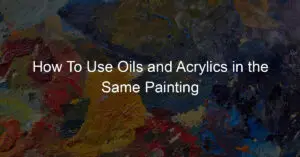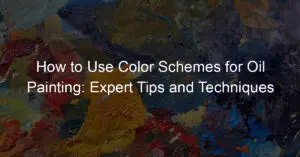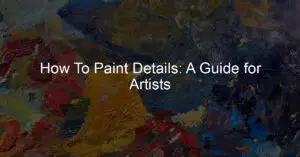Oil paint spills on vinyl floors can be quite frustrating for homeowners and artists alike. Vinyl flooring is popular due to its durability, affordability, and ease of maintenance, but oil paint can create a challenge when it comes to removing it. This article is here to help guide you through the process of safely and effectively removing oil-based paint stains from your vinyl floor.
Start by understanding the nature of oil-based paints; they can be stubborn to remove as they create a strong bond with the surface they’re applied to. It’s essential to act quickly to avoid having a permanent reminder of your mishap on your floor. With a combination of the right techniques, materials, and patience, you can restore the beauty of your vinyl floor.
In the following paragraphs, we will go through various methods for addressing these spills and stains, discussing different household items and commercial products you could use. To ensure a successful outcome, it’s important to follow the instructions and safety precautions for each method, as well as being aware of your vinyl floor’s specific requirements and limitations.
Identifying Paint Types
Before attempting to remove oil paints from your vinyl floor, it is essential to identify the type of paint you are dealing with, as different paints require different removal methods. Generally, there are three main types of paint commonly used in households: water-based, oil-based, and latex paint. Some other paint types include acrylic paint and spray paint.
Water-based paints include latex and acrylic paints, which are composed of pigments suspended in a water-soluble, polymer-based emulsion. These paints are known for their fast drying times, low odor, and easy application. They can typically be cleaned up with soap and water while they are still wet.
Oil-based paints, on the other hand, are made with natural or synthetic oils. They have a longer drying time than water-based paints and a higher durability, meaning they may be more challenging to remove. You will need a solvent such as mineral spirits or turpentine to clean up oil-based paint spills.
Latex paint is a water-based paint that contains a synthetic latex binder, providing flexibility, durability, and resistance to weathering. It has become a popular choice for interior and exterior surfaces due to its ease of application, fast drying time, and low odor.
Acrylic paint is another water-based paint that shares many similarities with latex paint. However, acrylic paint has a more significant pigment load, and its binder is based on acrylic polymers, making it more versatile and suitable for various surfaces, including vinyl floors.
Spray paint is a type of paint that comes in aerosol cans and is applied by spraying onto the surface. It can be water-based, oil-based, or solvent-based, depending on the formulation. Identifying the base of the spray paint is essential for determining the appropriate removal technique.
By understanding the different paint types and their properties, you can ensure that you apply the most effective method to remove oil paint from your vinyl floor. For an oil-based paint, solvent-based cleaning techniques will be required, while water-based paints may be removed with soap, water, or other milder solutions.
Removing Fresh Paint Stains
When dealing with wet paint on a vinyl floor, it is essential to act quickly to prevent the paint from setting. Start by gently blotting the area with paper towels to absorb as much of the wet paint as possible.
Next, prepare a solution of mild detergent and water to clean the vinyl floor. A good ratio would be a few drops of detergent per quart of water. Take a clean cloth, dip it into the solution, and gently wipe the paint-stained area using a circular motion.
After wiping the area with the detergent solution, rinse the cloth in clean water and use it to remove any soap residue from the floor. Make sure to be gentle during the whole process, as scrubbing too hard could potentially damage the surface of the vinyl floor.
By acting quickly and using the right cleaning agents, you can confidently handle fresh paint stains on your vinyl floor and maintain its pristine appearance.
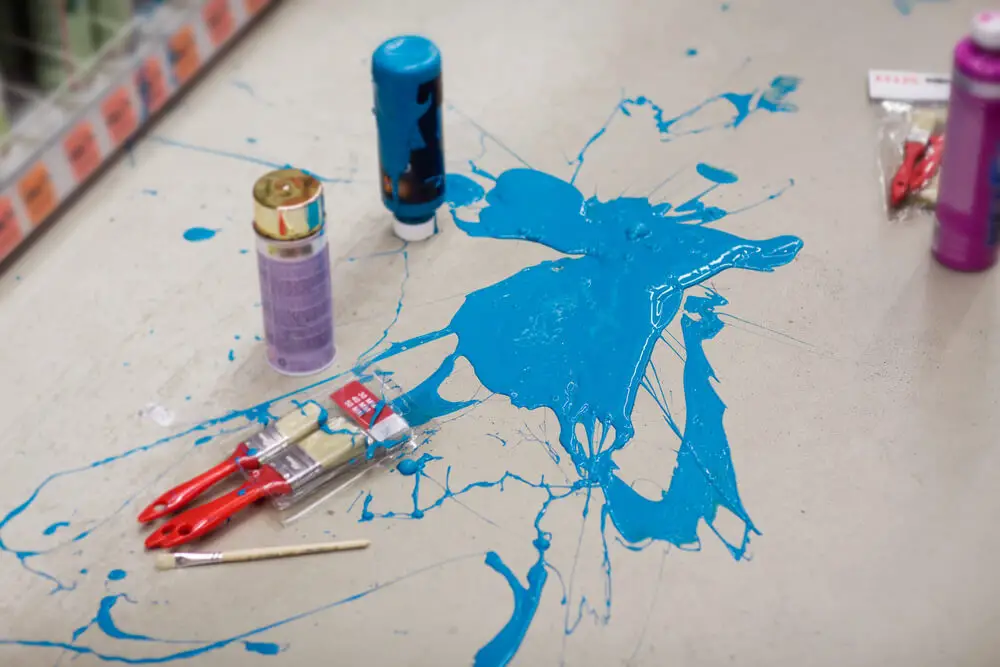
Removing Wet Water-Based Paint
When dealing with wet water-based paint on your vinyl flooring, acting quickly is key to ensuring an easier cleaning process. The initial step should involve dabbing the paint spill with a clean towel, taking care not to spread it further on the floor’s surface.
Next, you’ll want to prepare a mixture of mild soap and warm water. This soapy water solution will assist you in effectively breaking down and lifting the paint from your vinyl flooring. It’s important to note that using an abrasive cleaner could potentially damage the surface of your vinyl, so sticking with mild soap as your cleaning agent is recommended.
After preparing the soapy water, dip a sponge into the mixture. With the dampened sponge, gently scrub the affected area in a circular motion. Ensure you don’t apply excessive pressure when doing this, as it might cause harm to the vinyl floor.
Be sure to rinse the sponge frequently to prevent redepositing paint particles back onto the vinyl. Continue this process of scrubbing and rinsing until the wet water-based paint visibly lifts from the floor.
To complete the cleaning process, use a clean towel to dry the area thoroughly. This helps to prevent any unintentional spread of residual paint, and it returns your vinyl flooring back to its pristine condition. In summary, proper materials and techniques are essential to effectively remove wet water-based paint from vinyl floors without causing damage.
Removing Wet Oil-Based Paint
To effectively remove wet oil-based paint from your vinyl floor, act quickly and follow these steps. First, gather the necessary supplies such as mineral spirits, a rag, water, and a bucket.
Begin by pouring a generous amount of mineral spirits onto a clean rag. Ensure the rag is damp, but not soaked with the solution. Carefully dab the wet oil-paint stain with the damp rag. Apply gentle pressure to remove the paint from the surface of the vinyl floor. It’s crucial not to rub or scrub, as doing so can cause the paint to spread and penetrate deeper into the flooring.
As you work on the stain, you might notice the mineral spirits becoming less effective in removing the paint. This is due to the spirits mixing with the paint on the rag, reducing their potency. To counteract this issue, frequently switch the area of the rag and reapply mineral spirits as needed. If the rag becomes saturated with paint, use a new rag to continue the process.
Once you have successfully removed the wet oil-based paint from the vinyl floor, it’s time to clean away any residue from the mineral spirits. Fill a bucket with warm water and soak another rag in the water. Squeeze the excess water from the rag, and carefully wipe the surface of the vinyl floor to eliminate any remaining traces of mineral spirits. This step is crucial to avoid potential damage to your floor from the solvent.
Finally, allow the vinyl floor to air dry completely. By following these steps, you can confidently and effectively remove wet oil-based paint from your vinyl floor while minimizing potential damage.
Removing Dried Water-Based Paint
Before you begin, gather these necessary items: latex paint remover, a plastic scraper, rubber gloves, and a soft cloth or sponge. Wearing rubber gloves will protect your hands from irritants present in the cleaning solutions.
First, dampen the soft cloth or sponge with warm water, and gently scrub the dried paint. This may soften and loosen it up. To speed up the process, you can use a hairdryer to provide additional heat. Make sure not to overheat the vinyl floor as this may cause damage.
Next, apply a latex paint remover on the dried paint stain. Follow the manufacturer’s instructions to ensure optimal results without damaging the floor. Allow the latex paint remover to sit on the dried paint for the recommended time.
Once the dried paint starts to soften, use a plastic scraper to gently peel it away from the floor. Be careful not to scratch the surface of the vinyl floor, as it can be delicate. Work in small sections and continuously apply more latex paint remover if needed.
After successfully removing the dried paint, thoroughly clean the area with a mixture of warm water and mild dish soap. This will help remove any residue left from the latex paint remover. Finally, rinse the treated area with clean water, and pat dry with a cloth or towel.
Remember to be patient and persistent throughout the process, as dried water-based paints can be stubborn to remove. By following these steps, you should be able to restore your vinyl floor to its original appearance.
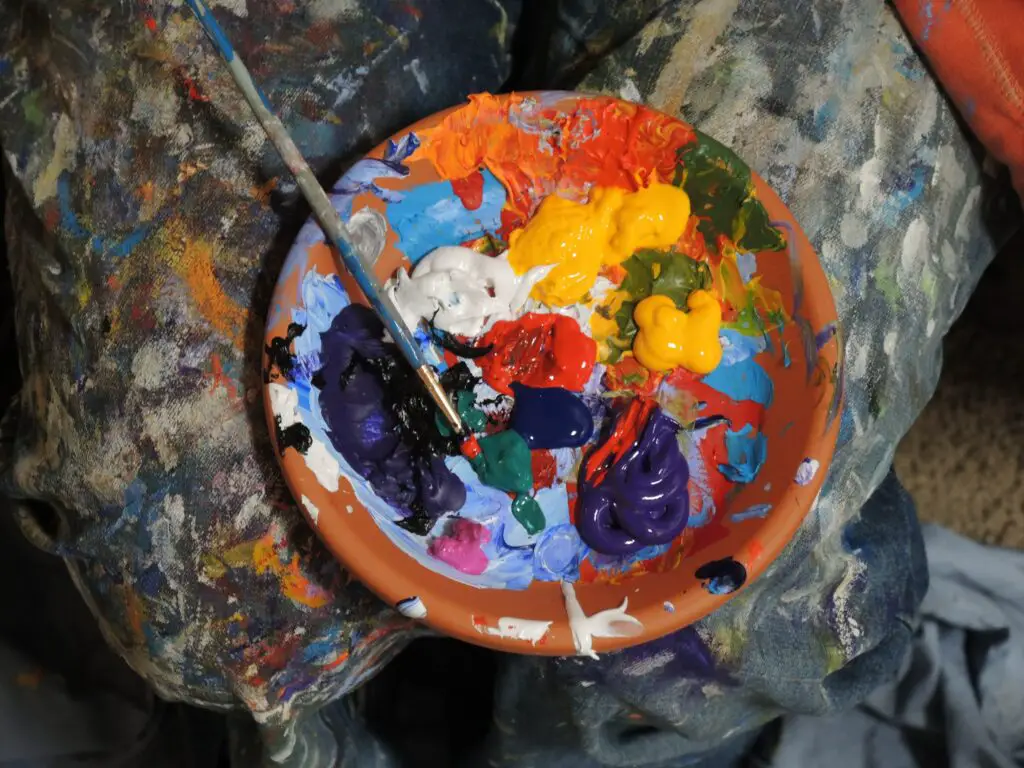
Removing Dried Oil-Based Paint
To remove dried oil-based paint from a vinyl floor, follow these steps:
- Gather the necessary materials: You’ll need turpentine, steel wool, protective gloves, clean rags, and mild soap.
- Put on protective gloves: Handling turpentine can be harmful to your skin, so always wear protective gloves when working with this solvent.
- Apply turpentine to a clean rag: Soak a clean rag in turpentine and wring out the excess to avoid dripping.
- Gently rub the affected area: Use the turpentine-soaked rag to gently rub the dried paint on the vinyl floor. The solvent will help break down the oil-based paint, making it easier to remove. Be patient and avoid applying too much pressure, as this could damage the vinyl flooring.
- Scrub with steel wool: If the paint is stubborn and doesn’t come off easily using the rag, you can use a piece of steel wool to gently scrub the affected area. Be cautious and apply minimal pressure to prevent scratching the vinyl surface.
- Wipe away residue: After the paint has been successfully removed, use a clean rag to wipe away any remaining turpentine or paint residue.
- Clean the area with mild soap: To finalize the process, mix mild soap with water and use a clean rag to gently clean the area. This will help remove any remaining residue and restore the vinyl floor’s appearance.
Remember to keep the room well-ventilated while working with turpentine, as the fumes can be harmful. Also, always test a small, inconspicuous area before applying any solvent to your vinyl flooring to ensure it won’t cause damage.
Cleaning Solutions and Tools
When it comes to removing oil paints from vinyl floors, using the right cleaning solutions and tools is essential. There is a variety of cleaning agents available, each with different strengths and purposes. Depending on the severity and type of paint stain, some options may be more effective than others.
Rubbing alcohol, also known as isopropyl alcohol, is an effective solution for removing latex and acrylic paint. Simply apply a small amount to a cloth and gently rub the affected area. It is important not to use too much alcohol, as it may damage the vinyl flooring.
Acetone, commonly found in nail polish remover, is another effective cleaning agent for more stubborn paint stains. Though it is a harsher chemical, it can help dissolve oil-based paint. When using acetone, always work in a well-ventilated area and test a small, inconspicuous section of the floor first to ensure it does not cause discoloration.
Commercial solvents, such as Goo Gone and PEC-12, are specifically designed to remove sticky residues and can also be used to eliminate oil paint stains. These products are readily available in hardware stores. Be sure to follow the manufacturer’s instructions and precautions when using commercial solvents.
Milder options for cleaning include a solution of vinegar and water or a gentle detergent mixed with water. These options can be less effective for removing oil-based paints but may work on lighter stains or latex-based paints. Additionally, you can try applying a liquid wax to the stained area and carefully scraping off the paint with a plastic scraper.
Turpentine is a powerful chemical traditionally used for dissolving oil paints; however, using it on a vinyl floor is risky. It may cause the flooring to become soft, brittle, or discolored. Avoid using turpentine or other very strong chemicals on your vinyl floors.
Lastly, it’s essential to have the right tools on hand during the cleaning process. Soft cloths, sponges, or microfiber cloths are excellent for applying cleaning solutions without scratching the floor. A plastic scraper can help lift paint from the surface without damaging the vinyl. Remember to be gentle and patient to minimize any potential harm to your floors.
In summary, each cleaning option has its strengths and limitations for removing oil paint stains from vinyl flooring. It is important to choose the most appropriate solution based on the specific type and severity of the stain. Always test a hidden area of your floor first to avoid any unwanted damage or discoloration. With the proper tools and cleaning solutions, you can successfully remove oil paint stains from your vinyl floors.
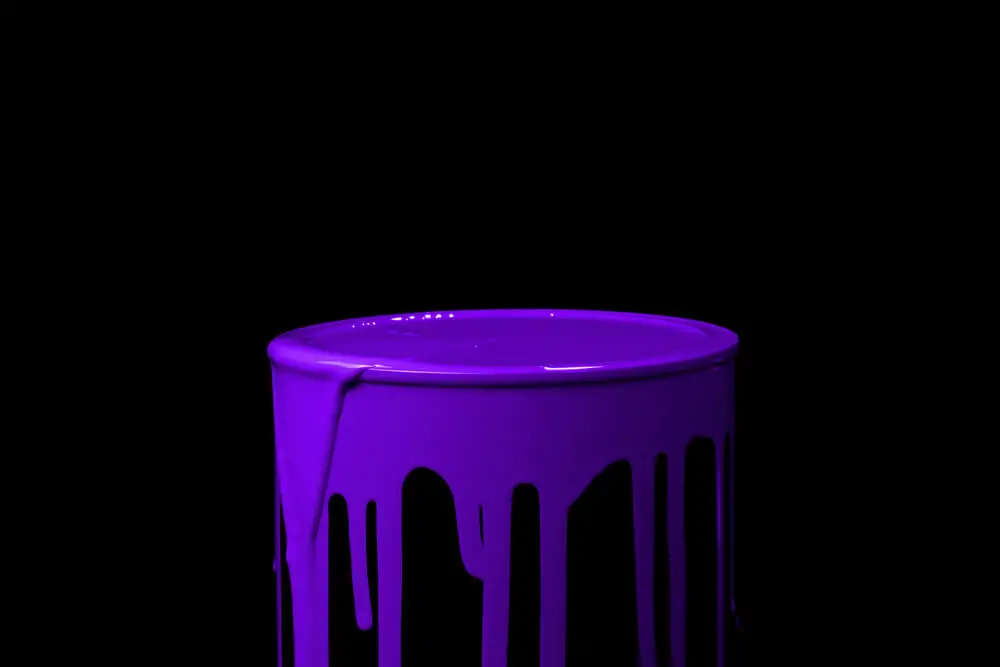
Safety Precautions
Before starting the process of removing oil paints from your vinyl floor, it is crucial to ensure your safety. Wearing the appropriate protective gear is a must. This includes using rubber gloves to protect your hands from direct contact with chemicals present in paint removers. The gloves will also prevent skin irritation and allergic reactions when handling paint residue.
Choosing the right paint remover is essential, as some chemicals can be harmful to your health and damaging to your vinyl floor. When selecting a paint remover, opt for a product designed specifically for use on vinyl floors to avoid damaging the surface. Always read the manufacturer’s instructions to understand how to use the product safely, and follow all stated guidelines.
Work in a well-ventilated area to protect yourself from inhaling potentially harmful fumes, especially if using a chemical paint remover. Open windows and doors, and, if possible, use a fan to help circulate the air. Adequate ventilation helps to decrease the risk of respiratory issues and other health hazards caused by exposure to paint remover fumes.
Additionally, avoid mixing different chemicals during the paint removal process. Mixing chemicals can result in dangerous fumes and reactions, potentially causing harm to both your health and the vinyl floor. If you need to use multiple products, make sure to test them separately to ensure compatibility and avoid adverse reactions.
By following these safety precautions, you can confidently and effectively remove oil paints from your vinyl floor while minimizing potential risks to your health and property. Remember to wear protective gear, choose the appropriate paint remover, work in a well-ventilated area, and avoid mixing chemicals to ensure a successful and safe paint removal process.
Maintaining Vinyl Floors
Vinyl flooring is a popular choice for many homeowners due to its durability, affordability, and ease of maintenance. To keep your vinyl floors looking their best, follow these simple yet effective cleaning methods.
To clean and care for your vinyl floors, start by sweeping or vacuuming the surface to remove dust, dirt, and debris. This should be done regularly, as the accumulation of dirt and grit can scratch or damage the floor over time.
When it comes to cleaning solutions for your vinyl floors, a mild detergent is normally more than enough to handle most stains and spills. Simply mix a few drops of dish soap with warm water, and you’ve got a perfect cleaning solution. For stubborn stains, you may use a specialized vinyl floor cleaner, but always test a small inconspicuous area first to ensure it won’t damage the floor.
Using a soft mop is key when cleaning vinyl floors. A soft mop, such as a microfiber or sponge mop, is gentle on the surface and effectively picks up dirt and grime. When mopping, make sure to wring out the mop thoroughly, as using too much water can seep into the seams and potentially damage the floor.
Here are a few additional tips to maintain your vinyl floors:
- Use doormats at entrances to minimize dirt being tracked in.
- Place felt pads under furniture legs to prevent scratching.
- Avoid using abrasive cleaners, scouring pads, or steel wool on your vinyl floors.
- Promptly clean up any spills to prevent stains.
- Always follow the manufacturer’s recommendations for cleaning and maintenance.
By following these guidelines, you can ensure your vinyl floors stay in great condition for years to come. Stay consistent with your cleaning routine and use the right tools and solutions for the job. Your vinyl flooring will remain an attractive and durable presence in your home.

Frequently Asked Questions
What is the best method to eliminate dried paint from a vinyl floor?
To remove dried paint from a vinyl floor, it is best to first soften the paint using a hairdryer or a heat gun on a low setting. Then, gently scrape the paint off with a plastic scraper or an old credit card. Be cautious not to scratch the floor. Finish by cleaning the area with a mild soap and water solution.
Can I use paint thinner on vinyl flooring without causing damage?
It is not recommended to use paint thinner on vinyl flooring, as it can cause damage to the surface. Instead, opt for a safer cleaning solution, such as rubbing alcohol or a mild dish soap solution. Always test any cleaning solution in an inconspicuous area before applying it to the affected spot.
Will Goo Gone effectively remove paint from vinyl?
Goo Gone is an effective product for removing paint from vinyl surfaces. Apply a small amount of Goo Gone to a clean cloth and gently rub it onto the paint stain, following the product’s instructions. Always test Goo Gone on an inconspicuous area first to ensure it doesn’t cause any damage.
How can I safely remove paint overspray from a vinyl floor?
To safely remove paint overspray from a vinyl floor, first, try wiping the area with a damp cloth. If the paint is stubborn, use a mixture of warm water and mild dish soap to loosen the paint. Gently scrub the area with a soft-bristle brush or non-abrasive sponge. Rinse the area thoroughly with clean water.
Is there a specific product to remove paint from vinyl upholstery?
To remove paint from vinyl upholstery, you can use a specialized vinyl cleaner or a mild solution of dish soap and water. Apply the cleaner with a soft cloth, lightly rubbing the stained area until the paint is lifted. Rinse thoroughly with clean water and pat the surface dry.
How do you clean up paint from a vinyl car interior?
To clean up paint from a vinyl car interior, use a gentle solution of mild dish soap and water, rubbing alcohol, or a specialized vinyl cleaner. Apply the solution with a soft cloth, gently rubbing the affected area until the paint is removed. Rinse the area thoroughly with clean water and pat dry.


